My caseload is primarily preschoolers and children in early elementary school, and I’m always incorporating some kind of toy into my speech therapy sessions. Parents are always asking me what kind of toys they should buy for their kids, and with the holiday season around the corner, I thought it’d be good to share with you some of my favorite toys to promote speech and language skills in children.
Children learn SO much in play. I love this quote from Fred Rogers: “Play is often talked about as if it were a relief from serious learning. But for children play is serious learning. Play is really the work of childhood.” Dr. Karen Purvis put it this way: “Scientists have recently determined that it takes approximately 400 repetitions to create a new synapse in the brain – unless it is done with play, in which case, it takes between 10-20 repetitions.” Play is THAT important. Let your children be little and explore. They are learning so much when they do!
Now, not all toys are created equal. Toys that promote creativity, movement, and pretend play skills are preferred. Electronic toys may be convenient, but they do all the talking for your kids. Quiet toys, or toys that do not require batteries, allow your child to be creative and come up with their own sounds! Below I’ve listed some of my favorite toys to develop speech and language skills. I’ve used these toys both with my own little girls at home as well as in the therapy room!
I love using Mr. & Mrs. Potato Head to target a variety of goals in speech. It is such a versatile toy and definitely a crowd pleaser, especially with my preschoolers! I use the potatoes to target pronouns, negation, body parts, articulation, prepositions, following directions, and verbs. I’ve had some kiddos on my caseload who just could not get their pronouns down, but as soon as we played with Mr. & Mrs. Potato Head for a few weeks, their percentages greatly increased! We work on “She wants the yellow hat” and “He wants the mustache” or “Give the red nose to him.” It literally is my most requested toy in speech. I recently wrote a blog that goes into more depth about how I target each of the different areas using potato heads. You can click here to check it out!
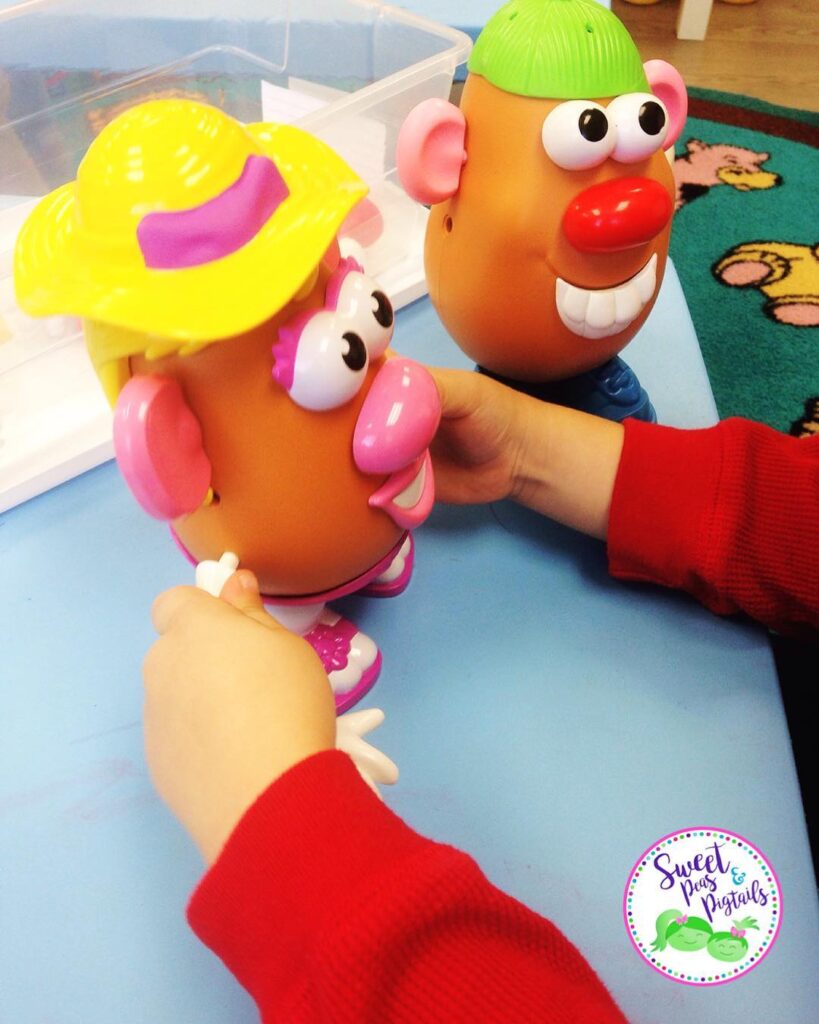
There is so much you can do with a farm set! Naming animals & their sounds, expressing the colors of the animals, articulation, vocabulary, verbs, prepositions, basic concepts and describing words. I also like to work on WH-questions and ask my kids “Who says moo?” or “Who drives the tractor?” or “What is it?” Some fun books to pair with farm sets include “I Went Walking” by Sue Williams and “Moo Baa La La La” by Sandra Boynton. Amazon has some cute farm sets! Here are some of my favorites:
Melissa & Doug Fold and Go Wooden Barn with 7 Animal play figures
Kiddie Play Farm Toys Set with Farm Animals for Toddlers (25 pieces)
There is SO much you can do with play food! I especially love the wooden play food sets. Work on pretend play, verbs, vocabulary, and articulation. I have a wooden baking set that the kids absolutely love! It includes cookies, cookie sheet, frosting toppers, an oven mitt, and wooden tools such as a knife, spatula, and rolling pin. You can get lots of /k/ practice in with this particular set! Also, the cookies and frosting have Velcro pieces on it so I like to work on prepositions (“Oh, you put the chocolate frosting on the cookie!”) and also in/out of the oven.
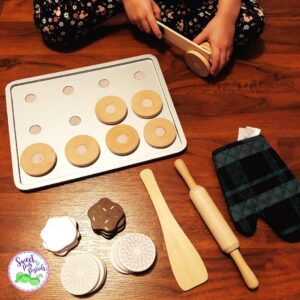
To target verbs, we cut the cookies, roll the dough, and spread the frosting. This is also fun to pair with a doll or the animals from the farm set. We work on feeding the different animals and talk about what they are eating. So fun! Here are some of my favorites on Amazon:
Melissa & Doug Slice and Bake Wooden Cookie Play Food Set
Melissa & Doug Pizza Party Wooden Play Food Set with 54 Toppings
I like to teach counting, shapes, and colors with my littlest friends while we play with blocks. I also like to work on requesting (“more block” or “I want block”), prepositions while stacking (“block on.”), and basic concepts (“big tower” and “little tower”). Playing with blocks enables children to be creative and use their imagination as they build robots, castles, or maybe houses. I also like to bring in animals while we are playing with blocks and hide them in various places. I may hide a horse behind the tower and ask, “Where’s horse?” to work on asking and answering questions as well as prepositions (behind). There are endless ways to encourage communication skills while playing with blocks! I love these sets:
Melissa & Doug Wooden Building Blocks Set - 100 Blocks in 4 Colors and 9 Shapes
Mega Bloks 80-Piece Big Building Bag, Classic
Doctor kits are wonderful at facilitating communication! We talk about emotions/feelings (the baby feels sick) and work on answering WH-questions. I may ask my kids, “Where is baby’s boo-boo?” or “What hurts?” and “What should we do to make baby feel better?” My preschoolers love playing doctor (as do my own little girls at home!). This is the one I have:
Disney Doc McStuffins ORIGINAL Doctor’s Bag- Exclusive
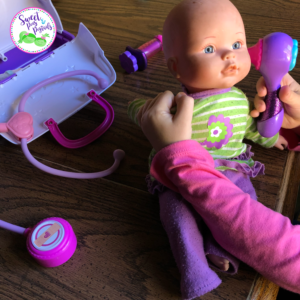
What are your favorite toys to promote speech & language skills? I’d love to hear! Check out my Teachers Pay Teachers Store for more fun speech & language activities!
(This post contains Amazon Affiliate links which means if you purchase something using my link I may make a small commission)
I absolutely love incorporating books into my speech therapy sessions! As a traveling SLP, I love that I can target a variety of goals with a single book. Read below to see some of my favorite books.
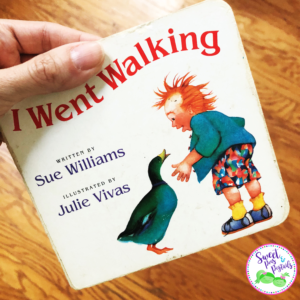
I’ve been using this book in speech for many years and it’s one of my all-time favorites! I remember hearing about this book at an ASHA convention as a new SLP and I knew I had to get it for my kids. Plus, it’s all about animals, so of course it’s a huge hit with children! There are many different goals you can target with this book.
-naming and describing animals
-inferencing
This book also uses repetitive language, which makes it fun for the kids to help read aloud!
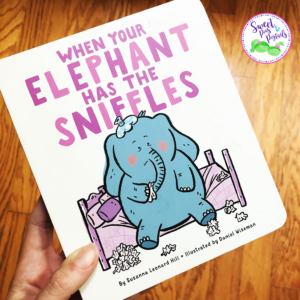
This is such a fun book about a little girl and all the things she does to help her sniffly elephant feel better. My kids love it and it’s perfect to use during cold and flu season. I love using this book in speech to cover a variety of different areas.
-teaching empathy and caring for others
-teaching about germs
-articulation, especially /s/ blends, /l/, and /ch/
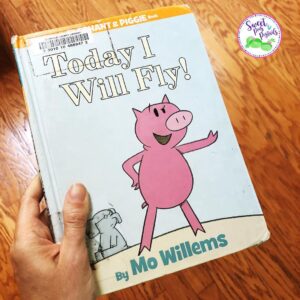
I really love this book (and all his other books!) by Mo Willems about two animal friends, an elephant and a pig. Elephant isn’t quite sure that his friend pig can fly, but pig tries really hard to make her dream of flying come true! There are so many areas that you can target in speech with this book.
-nonverbal language (Elephant and Piggie are quite animated so we work on interpreting body language, facial expressions, and emotions)
-teaching encouragement
-articulation, especially /l/ and /l/ blends
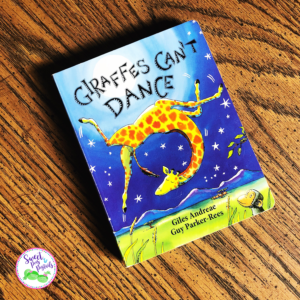
This is a book about a giraffe named Gerald who wants to dance but can’t. He gets teased by the other animals when he starts dancing which leaves him feeling sad and lonely. He meets a cricket who encourages him, telling him he’s not a bad dancer but that he hasn’t found the right music. I love using this book to target a ton of speech and language targets!
-teaching children about the importance of accepting their own differences, as well as the differences of others.
-adjectives
-articulation
-rhyming
-plurals
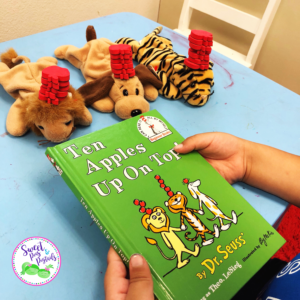
Even though the apple theme is perfect for back to school and the fall season, I literally use this book all the time! I carry around three of my old beanie baby friends (Roary the Lion, Bones the Dog, and Stripes the Tiger) that I have lying around my house from years ago, and it works out perfectly with this book. The kids enjoy putting “apples” on top of each animal’s heads as we read along and they seem to never get tired of it! I use this book to target so many goals!
-basic concepts (more, less, etc.)
-counting
-prepositions
-feelings
-possessives
What are your favorite books to use in your speech therapy sessions?! I’d love to hear!
Check out my Teachers Pay Teachers Store for more fun speech & language activities!
When Your Elephant Has the Sniffles
(This post contains Amazon Affiliate links which means if you purchase something using my links I may make a small commission)
Fall is here, even though it doesn’t feel much like it here in Central Florida with temps in the 90’s this first week of October! I definitely can’t wait for it to cool down a little! Even though it still feels like summer around here, I’ve been trying to bring a little fall into my therapy sessions. Read below to see my favorite ways!
How cute are these apple mini erasers I picked up at the Target Dollar Spot?! I’ve been using them since school started and they are perfect for fall! I primarily use them as markers on my negation flashcards, smash mats, and bingo games and the kids just love them! Sometimes, I’ll lay out a few erasers and have my kiddos tap an apple while counting syllables as well.
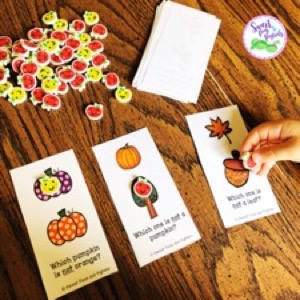
So far, I’ve been all about apples in speech! We’ve been using a lot of red Play-Doh in our sessions on my apple-themed apraxia smash mats! I use these mats to target apraxia and articulation delays and the kids love making “apples” after they say their words!
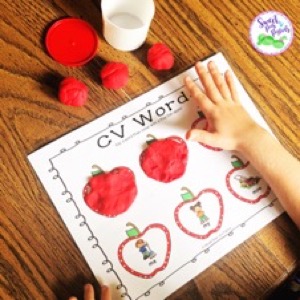
Continuing with the apple theme (can you tell I like apples?!), I love using the book, “Ten Apples Up on Top!” with my kiddos in speech. We work on basic concepts, counting, prepositions, actions, feelings, and possessives. I usually have my students count along and put apples on top of lion, dog, and tiger’s heads as we read and they just love it!
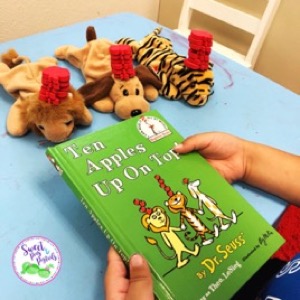
I also created a fun, little fall-themed book that I use a lot with my little ones this time of year! I use it for syllables, articulation, fall vocabulary, colors, and WH-questions. You can get Pumpkin, Pumpkin What Do You See? for FREE in my TPT store!
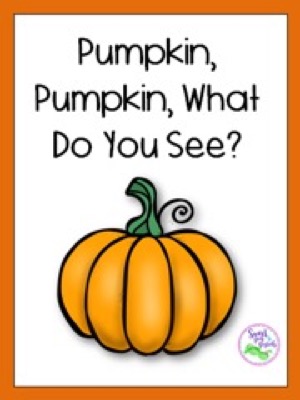
Another fun, fall freebie that is in my store is my Past Tense Verbs Thumbprint Leaves. The kids name the verb in the leaf and then say the past tense form of the verb. After that, they get to use an ink pad to make a thumbprint leaf! Of course, if you don’t have an ink pad, you can always cover the leaves with game chips, mini erasers, use bingo daubers, or smash with Play-Doh after laminating!
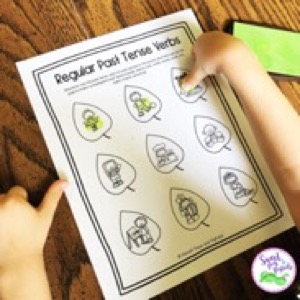
I’m all about sensory bins in my sessions! I picked up these leaves at the dollar store and made a quick, easy fall sensory bin! I usually just throw in any kind of flashcards for a quick, fall activity! Pictured here is my Fall Preposition Bingo game!
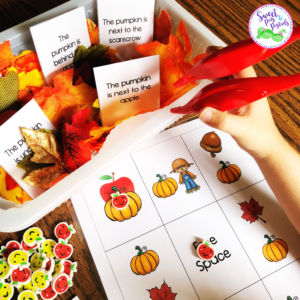
How do you incorporate fall into your speech therapy sessions?! I’d love to hear!
Check out my Teachers Pay Teachers Store for more fun fall speech & language activities!
(This post contains Amazon Affiliate links which means if you purchase something using my links I may make a small commission)
I love that I can do SO much in speech with just a box of common objects! I have a box of things I’ve collected over the years, including my old phone, socks, a flashlight, sunglasses, ball, comb, cup, an old watch, and some toys from my kids. I like to store everything in a clear storage box or when I’m traveling from site to site, I just throw them in a big freezer-size Ziploc bag and toss it in my therapy bag. Read on to see the 10 ways I use common objects in my speech sessions.
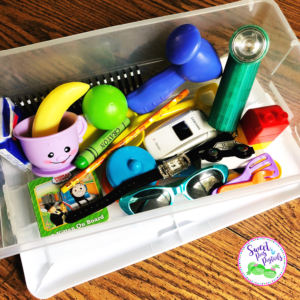
Ok, so this one is a given, but it’s so important! I start by placing two or three items in front of my student and asking them to point to the phone for example. Once they have learned to identify the objects, we move on to naming them. I reverse the scenario and have them be the teacher, telling me which object to find. I may also work on a little articulation if needed during this step of naming objects.
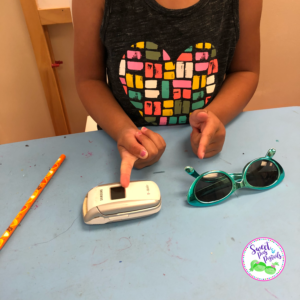
Working on functions is so easy to do with a box of objects. First, we work on identifying functions (“Which one do we throw?” Or “Which one tells time?”) from a field of two or three. After we’ve mastered identifying object functions, we move on to expressing object functions and they tell me how we use each item.
In my box I have sunglasses, a spatula, a shovel, a teacup, a hammer, and a banana, making it easy to work on counting syllables or producing multisyllabic words. If you are working on syllables, keep this in mind as you find objects to use in your box.
While we have the box out, I may ask a WH-question about the different objects such as “Why do we wear sunglasses?” or “When do you need a comb?”
The kids actually are really fascinated by the box, I don’t know what it is! My students especially enjoy asking for my very old cell phone! Depending on their level, I’ll have them ask using a phrase or sentence “more phone” or “I want ball.”
Talk about the colors and other descriptors and add words to make utterances more complex such as “I want the green ball” or “I want the little book.”
Purposefully fill your box with many different kinds of items within the same category and have your student separate the objects into the different categories. For example, throw in some different play foods, some school supplies, some toys, and maybe some small clothing items such as a pair of socks and a scarf. Baby or doll clothing is great for this because everything is so tiny!
Target prepositions by hiding the various items in the bag, under the table, next to/in between other items. I also may have my student tell me where to hide the items to focus on expressing those location words.
You can target tons of verbs with different objects! We talk about rolling, throwing, and bouncing the ball, or talking on the phone, digging with the shovel, cooking eggs in the pan, etc. To target past tense verbs, I’ll have my student roll the ball for example, and ask “What did you just do? You ____ (rolled) the ball!”
Pronoun work is easy to sneak in with a box of different items. Work on “my cup” or “your crayon.” We also may grab some dolls or other stuffed animals and work on “he,” “she,” “his,” and “hers” while giving the different items to the designated dolls. “He wants the carrot, it’s his.” “She wants the banana. It’s hers.”
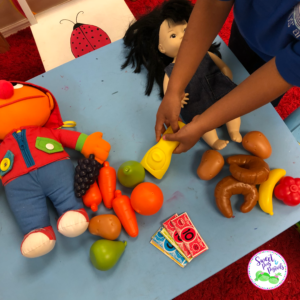
How do you use common objects in speech?! I’d love to hear!
Check out my Teachers Pay Teachers Store for more fun speech & language activities!
(This post contains Amazon Affiliate links which means if you purchase something using my link I may make a small commission)
I feel like Play-Doh is totally one of those must-have staples in any speech room. Having Play-Doh around seriously makes my life as a speech therapist easier. The kids love it, you can use it to target tons of speech and language goals and it’s so engaging! It also can be a good conversation piece, like the time my yellow Play-Doh matched my yellow pants!
Read below to find out how I use Play-Doh with my kids to target a variety of goals!
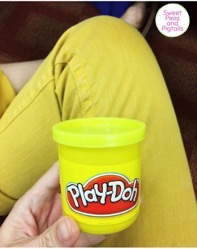
With so many options to choose from, Play-Doh is perfect for targeting requesting. My kids can choose a color, request to open the Play-Doh and request which Play-Doh toy they want to use (roller, animal shape, etc.).
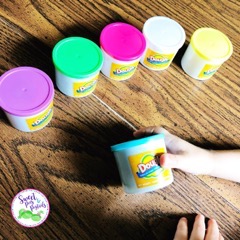
So much fun working on following directions activities with Play-Doh. The kids don’t even know they’re working! To target one-step directions with modifiers, I might ask the child to make a green snake or put the blue circle in the cup. For two-step directions, I may ask the child to make a yellow duck then make a purple turtle. You can make it more difficult by adding temporal concepts (before/after), more colors, and more steps! Super easy and fun!
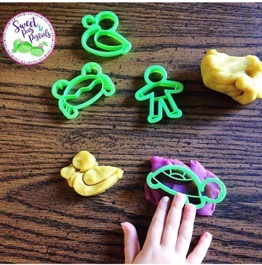
To work on negation, you can ask your students, “which one is not yellow?” or “which one is not a duck?” Again, most kids don’t even realize you’re working on their goals!
Having Play-Doh in your speech room or bag is also a good thing because it’s an easy way to target basic concepts! I like to use it to work on size, shape, color, quantitative concepts, qualitative concepts, and same/different.
We have lots of fun making animals, foods, letters, shapes, and all sorts of other things out of Play-Doh! Such an easy, fun way to target categories!
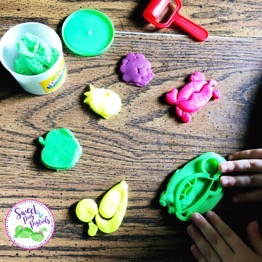
Have you heard of Play-Doh smash mats? They are functional, interactive, and great for getting in lots of repetitions during your sessions! I’ve created some gum-ball apraxia of speech smash mats that I like to use with my kids! Once laminated (or in a sheet protector), you can use over an over again with your kiddos. Just roll the Play-Doh into pre-made balls and then have your students smash the word after they say it!
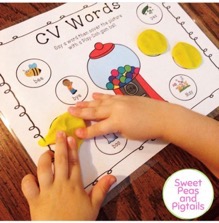
One way I use Play-Doh to target vocabulary is by using it with my pre-school vocabulary smash mats! The kids love smashing the pictures! We work on farm and zoo animals, sea life, insects, clothing, food, things around the house, etc. These mats are also great for categories!
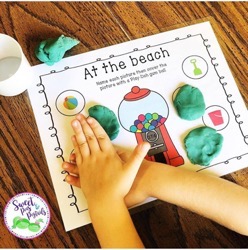
Sometimes we work on rhyming while playing with Play-Doh. For example, if the child makes a snake, we will try to think of words that rhyme with snake. Another way I like to incorporate rhyming into my sessions with Play-Doh is by using my rhyming lollipop smash mats! We work on identifying and expressing rhymes with these mats and the kids love it because they’re making “lollipops.”
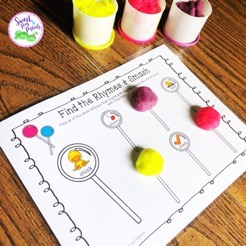
It’s so much fun to make letters with our dough! We like to talk about the letter and what sound it makes and then try to think of words that start with that sound.
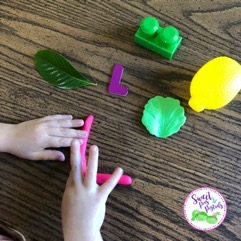
It’s pretty easy to sneak in some WH-question work while making things! For instance, if a student makes a ball, I might ask them, “What do you do with a ball?” or “Where do you play with a ball?” Another way I target this goal is by using my WH-question smash mats! I ask my child a question and they get to smash the answer!
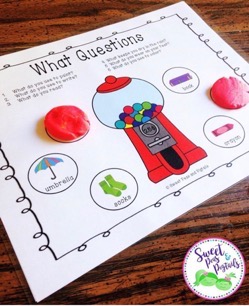
How do you use Play-Doh in speech?! I’d love to hear!
Check out my Teachers Pay Teachers Store for more fun speech & language activities!
A few months ago, I snagged some adorable spring-themed mini erasers on Amazon and I'm kind of obsessed with them! My kids have gone crazy over them as well and I have found some fun ways to incorporate them into my therapy sessions. Read on to find out how I use these adorable erasers in speech!
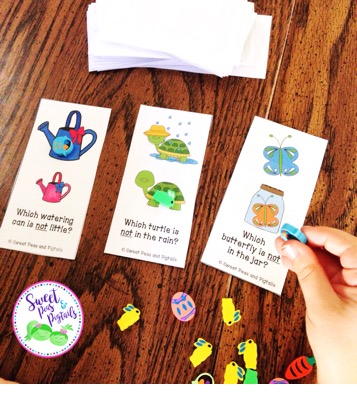
To change bingo games up a bit, I use mini erasers as markers on the answers instead of game chips! Sometimes I hide them in a sensory bin and my students take a turn finding an eraser to put on their boards. It's also fun to use the erasers on my negation flashcards! Pictured here is my Spring Negation product.
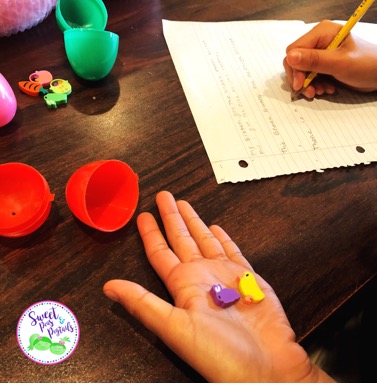
I use the erasers as writing prompts to help formulate sentences with some of my older kids. Depending on their level, I'll choose 2-4 mini erasers and have them write a sentence about them. During the Easter holiday, they're also fun to hide in Easter eggs! Here, my student chose an egg and in it was a purple bunny and a chick. She formed the sentence, "The purple bunny sees the yellow chick." You can work on verb tenses (saw) as well!
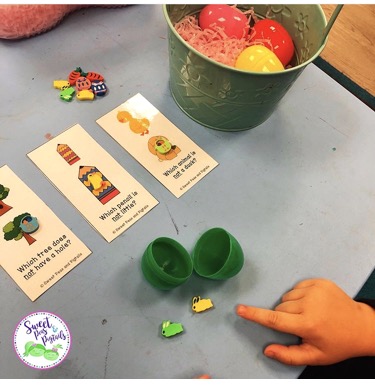
To work on negation, take two erasers and ask the child a question such as, "Which bunny is not green?" My preschoolers love this! I usually incorporate this activity while looking at negation flashcards. My kids have to do five flashcards then they get to choose an egg with erasers or find a few in a sensory bin.
Some of my kiddos are working on expressing how two items are the same and how they are different. Again, take two erasers and talk about the similarities and differences between the two!
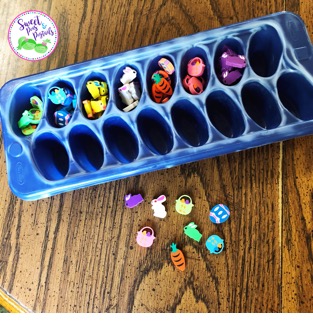
There’s sooo much you can do here. I like to break out an ice cube tray and have my kids sort according to color, beginning sound, syllable, etc. Or, if you don’t have an ice cube tray on hand, grab a sheet of paper, a sharpie, and make up your own sorting sheet!
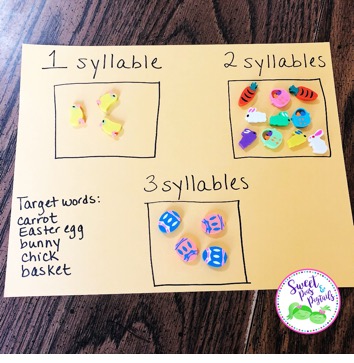
How do you use mini erasers in speech?! I’d love to hear!
Check out my Teachers Pay Teachers Store for more fun speech & language activities!
March is so much fun in speech! With spring just about here, St. Patrick’s Day in the middle of the month, and Easter right around the corner, there are tons of things you can do, especially with sensory bins! I absolutely love using sensory bins with my students. Using a sensory bin is a great way to build speech and language and I’ve found that it keeps my children’s attention for longer periods of time. All you need is a plastic bin of some sort and some filler items! And I’m all about easy, so read below to find simple (but still fun!) sensory bin ideas you can use in your therapy room!
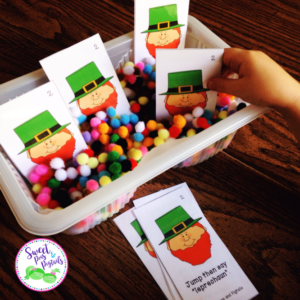
I found these mini pom poms on Amazon that work so well as a rainbow sensory bin for St. Patrick’s Day! So easy and I love just throwing any kind of card that I’m working on in the bin. Here, I put my St. Patrick’s Day Following Direction Cards inside and the kids had to draw a card and complete the command.
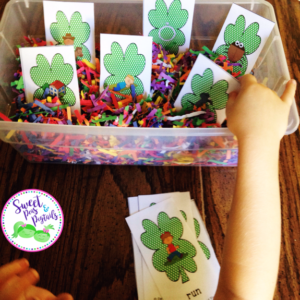
To make another rainbow bin, I just shredded different colored construction paper. See, super simple! 😊 I actually shredded two sheets of each color of the rainbow and I had more than enough paper to fill my bin! I threw in my St. Patrick’s Day Articulation Cards for a fun speech activity.
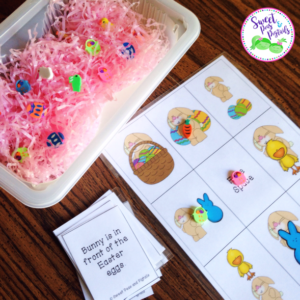
For an Easter/spring theme, use any colored Easter grass and hide items in there whether it’s flash cards or other objects. I like to hide flashcards, small toys, or spring-themed mini erasers in there! Here, we were playing Easter Preposition Bingo, and then after the students took their turn, they got to search for a mini eraser in the bin and put it on their answer! You can even extend the activity once it’s over by talking about how the erasers are the same and how they are different and sort them into categories. So fun!
Well, there you have a few sensory bin ideas for March. Do you have any fun sensory bins you like to use during the Spring season? I’d love to hear your ideas!
Check out my Teachers Pay Teachers Store for more fun speech & language activities!
I have a few kids on my caseload that are working on maintaining the topic of conversation. Using a ball in speech has really helped my students understand the concept. It’s crazy to think of how many uses a simple ball has in therapy! Read on to find out how I use this one simple object to help children understand how to keep the conversation going.
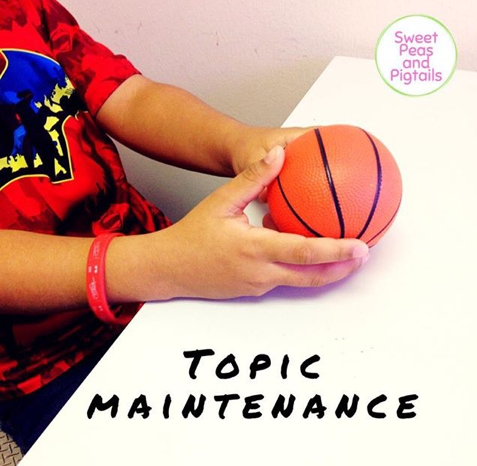
Luckily I had a small basketball on hand for my student who is a basketball fan, so that made the activity that much more fun! It can be any kind of ball, but I prefer it to be about the size of the child’s hands.
My topic for this particular student was pizza. When he had the ball, he told me what kind of pizza he liked and then passed the ball to me. The whole idea behind the ball is that whoever is holding the ball speaks. As soon as the person is done talking, it is passed to the other person.
When my student gave me the ball, I was hoping he would ask me what kind of pizza I liked in order to keep the conversation going. It took some prompting, but eventually he spontaneously asked me some good questions and made a few comments. Not only are asking and answering questions important skills to keep the conversation going but they are also important social skills to possess!
How do you target topic maintenance with your students? I’d love to hear your ideas!
I love using Mr. & Mrs. Potato Head in speech with my little ones. I can seriously target a variety of goals with this one toy. Not only is this a versatile toy, but it’s also a crowd pleaser with my preschoolers! Read below to find out how I use potato heads in my sessions.
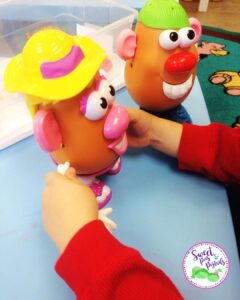
Many of my kiddos have difficulty with “he” and “she.” With my preschoolers, it’s mostly “he” for everything. I start out by putting the girl shoes on one potato head and the boy shoes on the other so they stand and then we kind of know who’s the boy and who’s the girl. Then, we take turns requesting for various items for our boy and girl potato heads by saying “He wants the (blue hat, etc.)” or “She wants the (yellow hat, etc.).” If my student continues to use “he” but places the item on the girl, we then talk about it and say our sentence again with “she.” To work on possessive pronouns, simply ask your student, “Whose (hat, etc.) is that?” and they must respond with “his” or “hers.”
The concept of negation is an area that I work on a lot with my children and I love that it’s so easy to target while playing with potato heads! I usually do this when we’re cleaning up. I might say, “Give me the hat that is not blue” or “Give me the arms that are not short.”
Potato heads are great ways to work on basic body parts. Sometimes I take it a step further and ask what we do with each body part (What do we do with our eyes? Our ears? Etc.). I may also ask, “Does he have eyebrows?” or “Does she have shoulders?” and then point them out on each other to work on more advanced body parts as well.
It’s always fun to name your potato heads with your student’s speech sound. Another way to tie in your speech sound is to find items or pictures that begin or end with the sound and give them to the potato heads. For example, if my child is working on /p/, I might give him some play foods that begin with /p/ such as a pear, peach, pancake, and pasta. At the word level you could start the sentence, “Mr. Potato Head is eating a…” and have your child fill in the blank. At the phrase level, maybe they could tell Mr. Potato Head to “eat pear.” And at the sentence level, then of course have them form a sentence such as “He is eating a pear.”
To target prepositions with potato heads, simply place one of Mr. or Mrs. Potato Heads’ items somewhere and ask the child to express where it is. For instance, I may put the nose under the table or next to the chair. You could also give your child a direction to follow such as “Put the blue hat behind the desk.”
Take turns giving and following directions with your kids as you build your potato heads. Include as little or as many steps as needed. For example, if I’m working on 2-step temporal directions with my kids, I might say, “Put the eyes on the girl before you put the hat on the boy.”
Sometimes our potato heads perform various actions such as running, jumping, walking, sitting, eating, etc. It’s also fun to pull out the action cards and place them in front of a potato head and say, “Mrs. Potato Head is singing,” for example.
There are so many ways to use potato heads in speech! Why not make it fun?!
Check out my Teachers Pay Teachers Store for more fun speech & language activities!
Materials for idioms are sometimes difficult to find, so I thought I’d create a product of my own. 😉 I have a student on my caseload who struggles with understanding idioms, and I feel like I’m always bending over backwards trying to teach him what they mean!
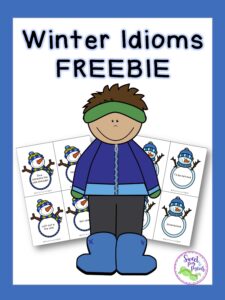
Included in this packet are 12 winter-themed idiom snowman flashcards as well as 12 definition snowman cards. Laminate and cut apart flashcards. I like to flip the cards over and play as a memory matching game by placing the idiom flashcards on one side of the table and the definition cards on the other side. I then have my students choose one idiom flash card and one definition flash card. If it matches, they get to keep the cards. The player with the most matches at the end of the game wins!
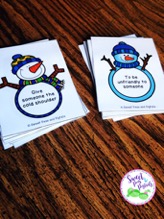
Another way you can play is to put the idiom cards in a sensory bin and have your student choose one at a time. Depending on their level, he or she can then match it to the definition or maybe even use it in a sentence independently.
I hope you enjoy this freebie! Let me know if it helps your kiddos!
Click here to download freebie!